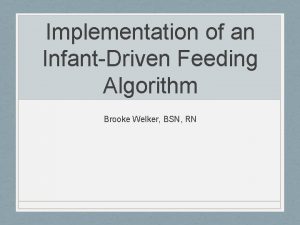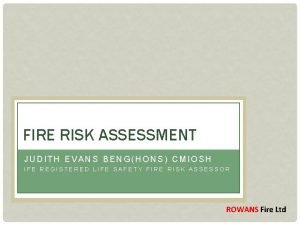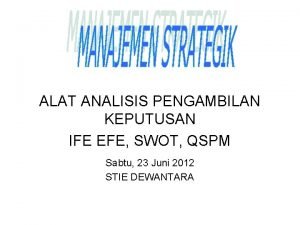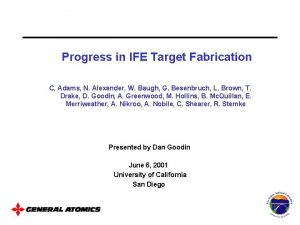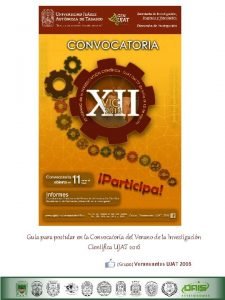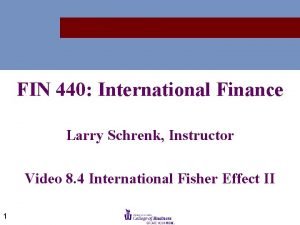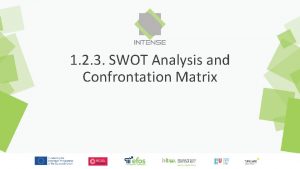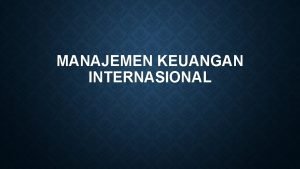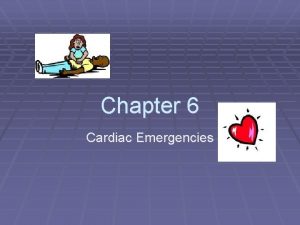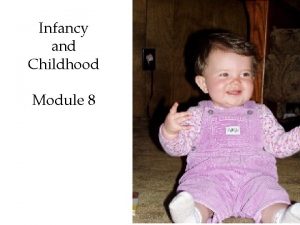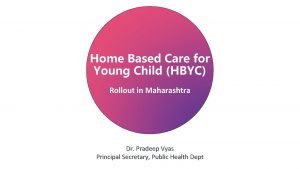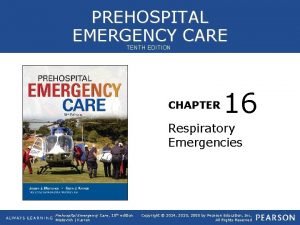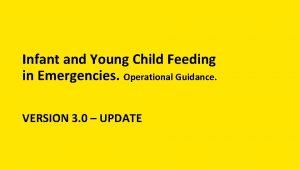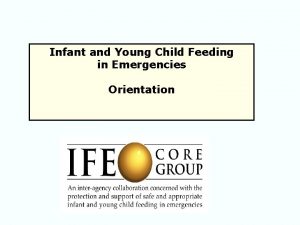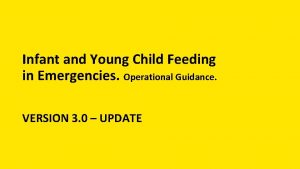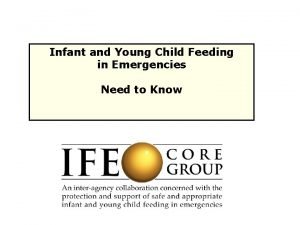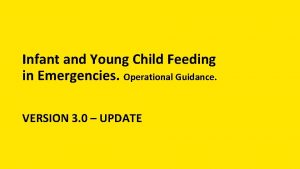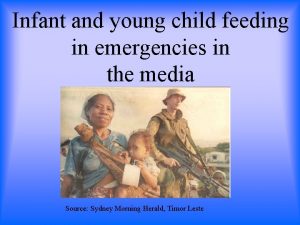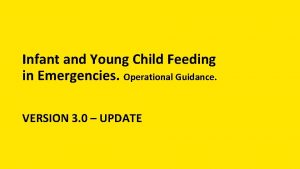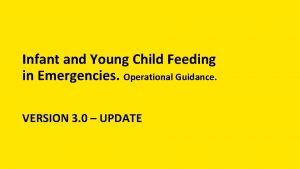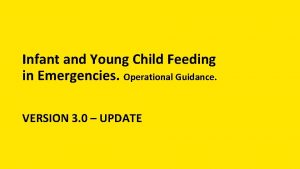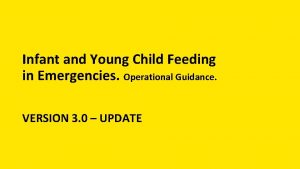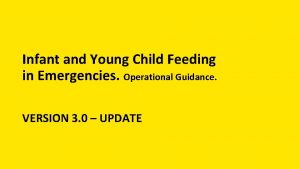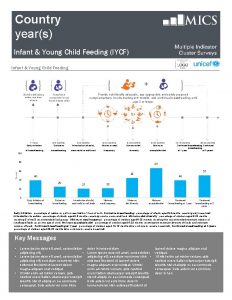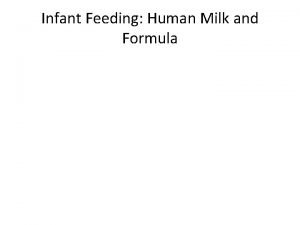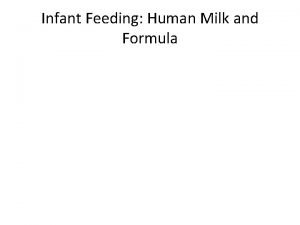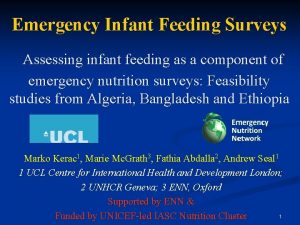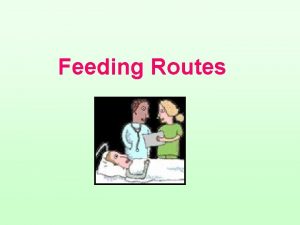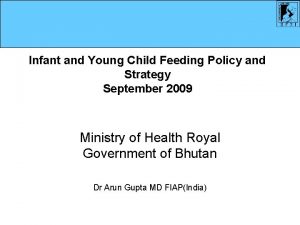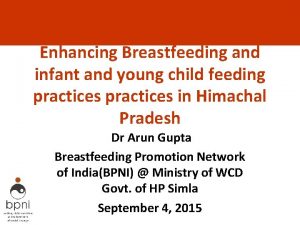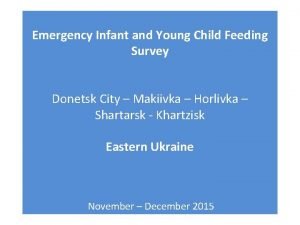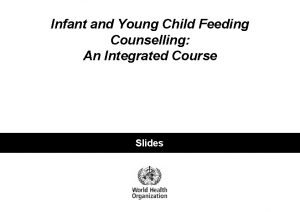Infant and Young Child Feeding in Emergencies IFE

























- Slides: 25

Infant and Young Child Feeding in Emergencies (IFE)

WHY is IFE important? BECAUSE INFANTS & YOUNG CHILDREN ARE EXTREMELY VULNERABLE

Even in healthy populations child morbidity and crude mortality can increase by 20% in 2 weeks

In emergencies rates of child mortality can soar from 2 to 70 times higher than average

Infants and children are the most vulnerable. . . Increased deaths (mortality) people of all ages Deaths/10, 000/Day children under 5 years Camp location Refugee Nutrition Information System, ACC/SCN at WHO, Geneva. For 1998 & 1999

YOUNG infants are particularly vulnerable Asad Zaidi, Unicef, A. Maclaine. Philippines, 2009

Risks of death highest for the youngest Deaths as % of admissions at therapeutic feeding centres in Afghanistan, 1999 Age (months) Golden M. Comment on including infants in nutrition surveys: experiences of ACF in Kabul City. Field Exchange 2000; 9: 16 -17 IFE 1/2

IFE 1/4 Times more likely to die if not breastfed Breastfeeding protects Especially the youngest infants Risk of death if breastfed is equivalent to one. Age in months WHO Collaborative Study Team. Effects of breastfeeding on infant and child mortality due to infectious disease in less developed countries: a pooled analysis. The Lancet 2000; 355: 451 -5

Risks of not breastfeeding Particular high risk of Diarrhoea and ARTI Malnutrition CAN LEAD TO: - ILL HEALTH, - POOR DEVELOPMENT - AFFECT CAN LAST FOR LIFE - DEATH Aceh

BOTSWANA Nov 2005 – Feb 2006: Unusually heavy rains, flooding Botswana under-5 diarrhoea Year Districts Cases Reporting 24 8, 478 Deaths 2004 Time Period Q 1 2005 Q 1 24 9, 166 21 2006 Q 1 12 22, 500 470 (True 24 numbers not known)

Risk factors for diarrhoea & death following flooding § § § Amongst children hospitalised (n=154): Not breastfeeding: 50. 0 (4. 5 – 100) Storing drinking water: 3. 7 (1. 5 – 9. 1) Overflowing latrines: 3. 0 (1. 1 – 8. 6) Standing water near home: 2. 6 (1. 1 – 6. 3) Caregivers not washing hands: 2. 5 (1. 1 – 5. 0) Risk factors for death (amongst hospitalised children): - not being breastfed (OR 8. 5, p=0. 04) - kwashiorkor (OR 2. 6, p=0. 03).

WHY? Why is there high infant morbidity & mortality due to artificial feeding in emergencies compared to breastfeeding?

Why? (1) Due to intrinsic contamination of infant formula – it is NOT sterile Photo credit: Ali Maclaine, 2006

Why? (2) Due to (a) lack of water Asad Zaidi, UNICEF Pakistan Water for sale in Pakistan, postearthquake A 3 month old bottle-fed baby needs 1 litre of water per day to mix with the formula powder. Another 2 litres are needed to sterilize the bottles and teats.

Photo credit: Ali Maclaine, 2006 (b) contamination of water (poor water & sanitation conditions) Bangladesh

Picture credit: yayasan IDEP foundation Often not helped by overcrowded conditions & people on the move… Aceh post-tsunami

Why? (3) Due to mode of feeding - bottles & teats are hard to sterilise especially with lack of water, fuel, equipment, etc. . . Pakistan, postearthquake Maaike Arts, UNICEF Pakistan Photo credit: Ali Maclaine 2007 Bangladesh, post cyclone Sidr, 2007

Lebanon, conflict 2006 – mother with donated formula – she was worried it was going to run out… Photo credit: Ali Maclaine, 2007 Photo credit: Ali Maclaine, 2006 Why? (4) Due to infant formula being made up incorrectly (over or under-diluted) Mother’s in rural Bangladesh where there is high illiteracy rate

Photo credit: Ali Maclaine, 2007 Why? (5) Due to lack of other supporting resources e. g. fuel, cleaning equipment, cooking pots, time constraints, etc People have lost cooking pots, etc after floods Bangladesh, 2007. People queuing for relief items after cyclone

Why? (6) Due to a change in circumstances… Even if artificial feeding before the crisis was ‘safe’. The emergency takes away those conditions and the mother’s ability to produce formula safely. USA – post Hurricane Katrina. Mother’s trying to formula feed in the Super Dome.

Why? (7) Because, infant formula does not have the protective properties of breastmilk or safe feeding mode breastfeeding

AIMS IN THIS EMERGENCY: Protect optimal IYCF • Initiation in the first hour after birth • Exclusive breastfeeding for 6 months (NOTHING else but breastmilk on demand day and night • Continued breastfeeding for 2 years or more • After 6 months – safe and appropriate complementary foods


• Ensuring that new born infants exclusively breastfeed from birth (TARGET PREGNANT WOMEN & MOTHERS OF NEW BORNS) • Means ensuring that exclusively breastfed mothers continue to do so. (TARGET EXCLUSIVE BREASTFEEDERS) • Ensuring that mixed feeding mothers of infants <6 months start exclusively breastfeed (TARGET MIXED FEEDERS) • Minimise risks of artificial feeding (TARGET ARTIFICIALLY FEEDING CAREGIVERS) • (Supporting complementary feeding – ensuring breastfeeding is continued at same level as before and ADD other nutritious foods. )

Response based on the Operational Guidance on IFE Available online: www. ennonline. net/ife (along with other IFE materials) Contact UNICEF: emonsef@unicef. org for IFE orientation, training, further IFE resources
 Infant driven feeding readiness scale
Infant driven feeding readiness scale Continuous feeding vs bolus feeding
Continuous feeding vs bolus feeding Discontinuity of development
Discontinuity of development Flcs mun
Flcs mun Space matrix of mcdonalds
Space matrix of mcdonalds Cmiosh
Cmiosh Ma trận swot của vissan
Ma trận swot của vissan Ife efe swot
Ife efe swot Ife in progress
Ife in progress Credencial ampliada al 200
Credencial ampliada al 200 Ife line
Ife line Ife line
Ife line Swot analysis confrontation matrix
Swot analysis confrontation matrix Efe matica
Efe matica Ife theory adalah
Ife theory adalah Ife laser
Ife laser Lesson 6: cardiac emergencies and using an aed
Lesson 6: cardiac emergencies and using an aed Chapter 19 endocrine and hematologic emergencies
Chapter 19 endocrine and hematologic emergencies Emt chapter 18 gastrointestinal and urologic emergencies
Emt chapter 18 gastrointestinal and urologic emergencies Chapter 28 lesson 1
Chapter 28 lesson 1 What is visitor pre registration in picme
What is visitor pre registration in picme Darien's father dictated who darien's
Darien's father dictated who darien's Hbyc training module in marathi
Hbyc training module in marathi Child workers some as young as 10
Child workers some as young as 10 Padi quiz 3 answers
Padi quiz 3 answers Chapter 16 respiratory emergencies
Chapter 16 respiratory emergencies
